
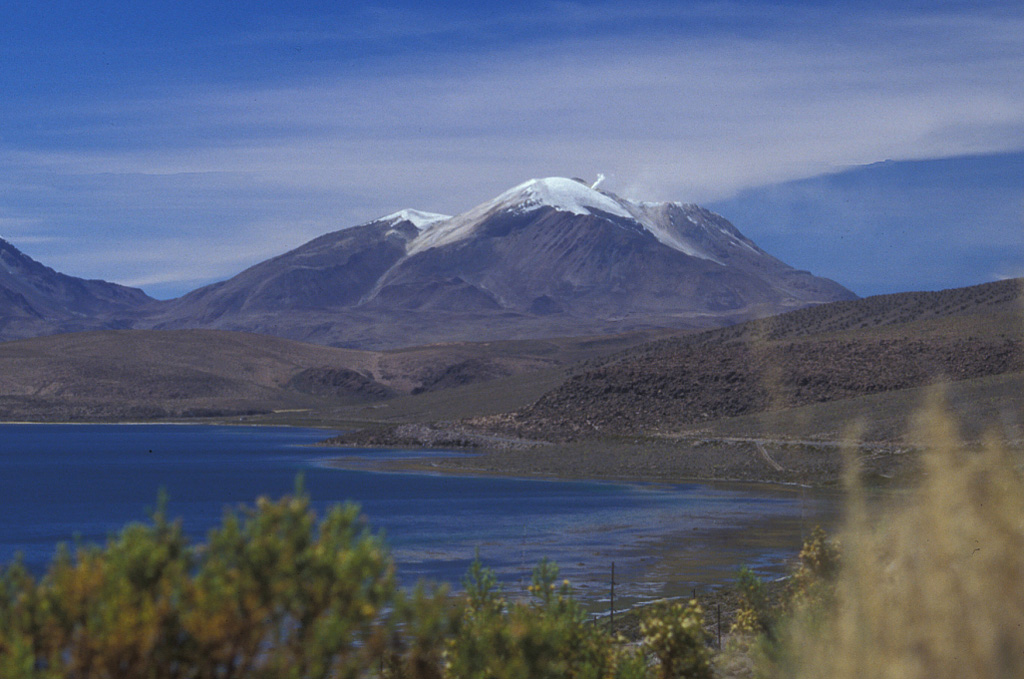
On 7 July OVDAS-SERNAGEOMIN reported that the Alert Level for Guallatiri was lowered to Green (the lowest level on a four-color scale) because activity had returned to the baseline levels observed prior to the Alert-Level increase in May. Baseline levels were characterized by low levels of seismicity, no deformation, and white emissions.
Source: Servicio Nacional de Geología y Minería (SERNAGEOMIN)
Quiet emission of vapor from summit crater and S flank fumaroles
On 19 and 20 July, quiet emissions and occasional denser puffs of white vapor from the summit crater were observed. A zone of fumaroles on the S flank of the volcano, free of snow and ~400 m below the summit, also released a similar amount of vapor as that from the summit crater.
Guallatiri, one of N Chile's most active volcanoes, is a symmetrical ice-clad volcano at the S end of the Nevados de Quimsachata volcano group.
Information Contacts: J. Sesiano, Département de Minéralogie, Université de Genève, 13 rue des Maraîchers, 1121 Genève 4, Switzerland.
On 7 July OVDAS-SERNAGEOMIN reported that the Alert Level for Guallatiri was lowered to Green (the lowest level on a four-color scale) because activity had returned to the baseline levels observed prior to the Alert-Level increase in May. Baseline levels were characterized by low levels of seismicity, no deformation, and white emissions.
Source: Servicio Nacional de Geología y Minería (SERNAGEOMIN)
OVDAS-SERNAGEOMIN reported that at 0004 and 0517 on 31 May volcano-tectonic events at Guallatiri with local magnitudes of 3.5 and 3.7, respectively, were detected by the seismic network. Very minor deformation was also detected. No other changes were observed in recent months; white plumes continued to rise 200 m. The Alert Level was raised to Yellow (the second lowest level on a four-color scale).
Source: Servicio Nacional de Geología y Minería (SERNAGEOMIN)
Reports are organized chronologically and indexed below by Month/Year (Publication Volume:Number), and include a one-line summary. Click on the index link or scroll down to read the reports.
Vapor plumes at 1-minute intervals
[This activity was initially attributed to Acotango in the Quimsachata Volcano Group. It is now thought to have originated from Guallatiri, further along the same line of sight as Acotango (figure 1). Investigation of Acotango volcano in 1987, by Oscar González-Ferrán, revealed no evidence of a recent eruption.]
The quoted material is a report from Robert Koeppen. "On 1 December at 0750, Robert Koeppen (USGS), Walter West (U. S. Embassy, La Paz, Bolivia), and Jaime Jauregui (Geological Survey of Bolivia) observed steam plumes erupting from a source near the crest of Nevados de Quimsachata. The observation was made from a point about 25 km to the NNE, near the W base of Volcán Nevado Sajama, Bolivia. Visibility was initially excellent, but within about 45 minutes cloud cover completely obscured the mountain's summit. Intervening peaks prevented exact determination of the vent, but the eruption appeared to originate from Cerro Acotango, either from the main summit or possibly immediately to the NW. If the eruption plume came from Volcán Guallatiri, the next possible source area along the line of sight, then it would represent a significantly larger eruption (figure 1).
"The eruptions produced white, billowing clouds that rose vertically above the Quimsachata crest, perhaps about 500 m, then drifted W. The eruptions occurred in episodic bursts, and, based on first sightings of the plumes, at intervals ranging from 45-75 seconds. One large plume drifted more NW and appeared to trail a curtain, possibly of ash fallout. Several bursts seemed particularly vigorous and appeared to consist of several plumes coalescing at higher levels."
Chilean forest service personnel based near Lago Chungara, roughly 20 km to the NW, reported that they had seen no activity, but visibilities in the area are frequently poor.
No eruptions are known in historic time from Cerro Acotango, but Yoshio Katsui and Oscar González-Ferrán (1968) mapped it as Holocene. Four historic eruptions bave been reported from Guallatiri, most recently in December 1960. Chilean geologists note that fumarolic activity from Guallatiri is apparently continuous but less vigorous than the plume emission observed 1 December.
Reference. Katsui, Y., and González-Ferrán, O., 1968, Geología del area neovolcánica de los Nevados de Payachata: Publicaciones del Instituto de Geología, Universidad de Chile, no. 29, 161 p.
Information Contacts: R. Koeppen, USGS, Reston, VA; L. López E., Univ. de Chile, Santiago.
Increased fumarolic activity; distant 1985 observation probably of this volcano
"During a reconaissance in the Nevados de Pachayata/Nevados de Quimsachata region between 2 and 5 December, vigorous fumarolic activity was observed at Guallatiri. The activity was much more intense than in previous years and the emissions were more frequent, occurring about every 30 minutes. Whitish-yellow columns rose 300-500 m above the volcano's central dacitic dome. Nearby secondary fumaroles extended from the principal vent onto the W part of the volcano (figure 2).
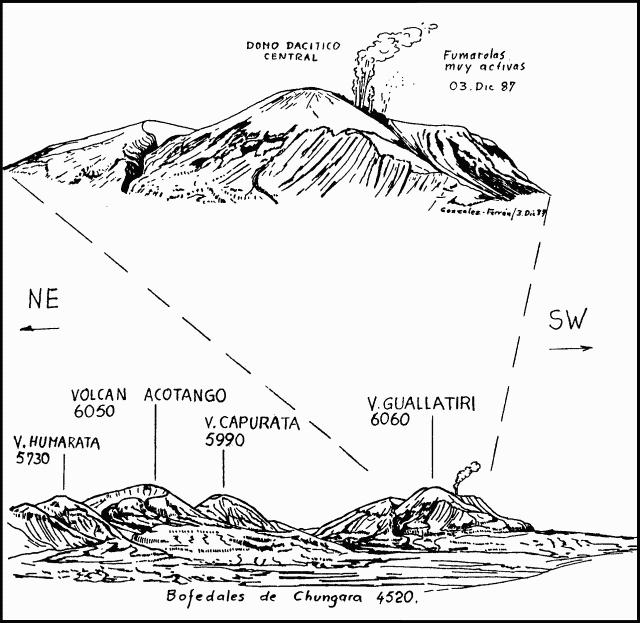 |
Figure 2. Sketch map of Guallatiri showing fumaroles active on 3 December 1987. Courtesy of O. González-Ferrán. |
"In December 1985, Robert Koeppen had observed (from the base of Sajama volcano 25 km to the NE) strong fumaroles that appeared to be from Acotango. During the 1987 reconaissance, the volcanoes Capurata, Acotango, and Humarata did not show any signs of activity; their craters were covered with ice and clean snow. Consequently, we believe that the activity observed by Koeppen was not from Acotango, but from Guallatiri [farther along Koeppen's line of sight from Sajama; see map in 10:11], which recently has notably increased its activity."
Information Contacts: O. González-Ferrán, Univ de Chile.
Strong fumarolic activity
Two strongly active zones of fumaroles were observed during a summit visit on 2 November 1990. The more intense fumaroles, 80 m below the . . . summit, produced a plume 200 m high accompanied by a jet-engine noise. Some boiling mud pools were also seen. The second zone, on the S side of the volcano at ~3,000 m elev, contained about 10 fumaroles. The volcano was otherwise snow-covered.
Information Contacts: P. Vetsch and R. Haubrichs, SVG, Switzerland.
Quiet emission of vapor from summit crater and S flank fumaroles
On 19 and 20 July, quiet emissions and occasional denser puffs of white vapor from the summit crater were observed. A zone of fumaroles on the S flank of the volcano, free of snow and ~400 m below the summit, also released a similar amount of vapor as that from the summit crater.
Guallatiri, one of N Chile's most active volcanoes, is a symmetrical ice-clad volcano at the S end of the Nevados de Quimsachata volcano group.
Information Contacts: J. Sesiano, Département de Minéralogie, Université de Genève, 13 rue des Maraîchers, 1121 Genève 4, Switzerland.
This compilation of synonyms and subsidiary features may not be comprehensive. Features are organized into four major categories: Cones, Craters, Domes, and Thermal Features. Synonyms of features appear indented below the primary name. In some cases additional feature type, elevation, or location details are provided.
Synonyms |
| Huallatire | Punata | Huallatiri |
|
|
||||||||||||||||||||||||
There is data available for 4 confirmed Holocene eruptive periods.
[ 1985 Dec 1 ] Uncertain Eruption
| Episode 1 | Eruption Episode | |||||||||||||||
|---|---|---|---|---|---|---|---|---|---|---|---|---|---|---|---|
| 1985 Dec 1 - Unknown | Evidence from Unknown | ||||||||||||||
|
List of 1 Events for Episode 1
| |||||||||||||||
1960 Dec 2 Confirmed Eruption Max VEI: 2
| Episode 1 | Eruption Episode | ||||||||||||||||||||
|---|---|---|---|---|---|---|---|---|---|---|---|---|---|---|---|---|---|---|---|---|
| 1960 Dec 2 - Unknown | Evidence from Observations: Reported | |||||||||||||||||||
|
List of 2 Events for Episode 1
| ||||||||||||||||||||
1959 Jul 15 ± 5 days Confirmed Eruption Max VEI: 2
| Episode 1 | Eruption Episode | ||||||||||||||||||||||||||||||
|---|---|---|---|---|---|---|---|---|---|---|---|---|---|---|---|---|---|---|---|---|---|---|---|---|---|---|---|---|---|---|
| 1959 Jul 15 ± 5 days - Unknown | Evidence from Observations: Reported | |||||||||||||||||||||||||||||
|
List of 4 Events for Episode 1
| ||||||||||||||||||||||||||||||
1913 Confirmed Eruption Max VEI: 2
| Episode 1 | Eruption Episode | |||||||||||||||||||||||||
|---|---|---|---|---|---|---|---|---|---|---|---|---|---|---|---|---|---|---|---|---|---|---|---|---|---|
| 1913 - Unknown | Evidence from Observations: Reported | ||||||||||||||||||||||||
|
List of 3 Events for Episode 1
| |||||||||||||||||||||||||
[ 1908 ] Uncertain Eruption
| Episode 1 | Eruption Episode | ||||
|---|---|---|---|---|
| 1908 - Unknown | Evidence from Unknown | |||
1825 ± 25 years Confirmed Eruption Max VEI: 2 (?)
| Episode 1 | Eruption Episode | ||||||||||||||||||||
|---|---|---|---|---|---|---|---|---|---|---|---|---|---|---|---|---|---|---|---|---|
| 1825 ± 25 years - Unknown | Evidence from Observations: Reported | |||||||||||||||||||
|
List of 2 Events for Episode 1
| ||||||||||||||||||||
There is no Deformation History data available for Guallatiri.
There is no Emissions History data available for Guallatiri.
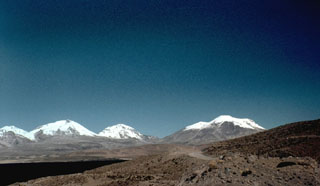 One of northern Chile's most active volcanoes, Volcán Guallatiri (right) is a symmetrical ice-clad stratovolcano at the SW end of the Nevados de Quimsachata volcano group. This view from the west includes three other peaks of the Nevados de Quimsachata group at the extreme left, Pleistocene Volcán Humarata and Pleistocene-to-Holocene Volcán Acotango and Capurata volcano (center). Minor explosive eruptions have occurred since the beginning of the 19th century from 6071-m-high Guallatiri volcano.
One of northern Chile's most active volcanoes, Volcán Guallatiri (right) is a symmetrical ice-clad stratovolcano at the SW end of the Nevados de Quimsachata volcano group. This view from the west includes three other peaks of the Nevados de Quimsachata group at the extreme left, Pleistocene Volcán Humarata and Pleistocene-to-Holocene Volcán Acotango and Capurata volcano (center). Minor explosive eruptions have occurred since the beginning of the 19th century from 6071-m-high Guallatiri volcano.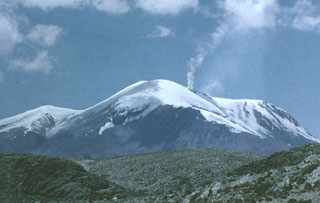 A vigorous steam plume rises from the summit ridge of Volcán Guallatiri, one of northern Chile's most active volcanoes. The ice-clad stratovolcano is seen here from the north and lies at the SW end of the Nevados de Quimsachata volcano group. The 6071-m-high Guallatiri is capped by a central dacitic dome or lava complex, with the active vent situated at its southern side. Minor explosive eruptions have been reported from Guallatiri since the beginning of the 19th century, and intense fumarolic activity continues.
A vigorous steam plume rises from the summit ridge of Volcán Guallatiri, one of northern Chile's most active volcanoes. The ice-clad stratovolcano is seen here from the north and lies at the SW end of the Nevados de Quimsachata volcano group. The 6071-m-high Guallatiri is capped by a central dacitic dome or lava complex, with the active vent situated at its southern side. Minor explosive eruptions have been reported from Guallatiri since the beginning of the 19th century, and intense fumarolic activity continues.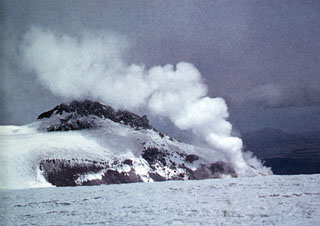 This prominent fumarole is located in the summit region of Guallatiri volcano. The vigorous fumarole lies 30 m below the summit on the western side and produces a very audible "jet-like" noise. Many solfataras are located along a 300 m section of the upper west flank of the volcano, and another five fumaroles are located on the south side of the central cone.
This prominent fumarole is located in the summit region of Guallatiri volcano. The vigorous fumarole lies 30 m below the summit on the western side and produces a very audible "jet-like" noise. Many solfataras are located along a 300 m section of the upper west flank of the volcano, and another five fumaroles are located on the south side of the central cone. Volcán Guallatiri rises to the SSE beyond Laguna Chungará, and steam rises from a prominent fumarole near its summit. The symmetrical ice-clad stratovolcano lies at the SW end of the Nevados de Quimsachata volcano group just west of the border with Bolivia and is capped by a central dacitic dome or lava complex. Thick lava flows can be seen on its lower northern and western flanks. Minor explosive eruptions have been reported from Guallatiri since the beginning of the 19th century, and intense fumarolic activity continues.
Volcán Guallatiri rises to the SSE beyond Laguna Chungará, and steam rises from a prominent fumarole near its summit. The symmetrical ice-clad stratovolcano lies at the SW end of the Nevados de Quimsachata volcano group just west of the border with Bolivia and is capped by a central dacitic dome or lava complex. Thick lava flows can be seen on its lower northern and western flanks. Minor explosive eruptions have been reported from Guallatiri since the beginning of the 19th century, and intense fumarolic activity continues.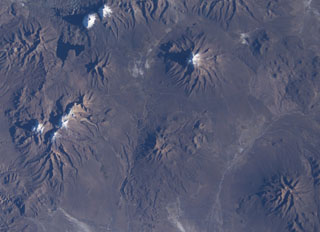 Snow capped volcanoes dot this NASA International Space Station image (with north to the upper right) taken along the Chile-Bolivia border. The snow-capped peak at the far left-center is Guallatiri volcano, and to its right are the three peaks of Nevados Quimsachata, which includes Acotango volcano. The two peaks at the upper left are Pomerape and Parinacota, with Laguna Chungara below. Nevado del Sajama in Bolivia lies at the upper right-center. At the lower right is the snow-free volcano of Macizo de Larancagua.
Snow capped volcanoes dot this NASA International Space Station image (with north to the upper right) taken along the Chile-Bolivia border. The snow-capped peak at the far left-center is Guallatiri volcano, and to its right are the three peaks of Nevados Quimsachata, which includes Acotango volcano. The two peaks at the upper left are Pomerape and Parinacota, with Laguna Chungara below. Nevado del Sajama in Bolivia lies at the upper right-center. At the lower right is the snow-free volcano of Macizo de Larancagua.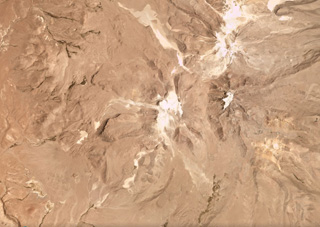 Glaciated Volcán Guallatiri is in the center of this December 2017 Planet Labs satellite image monthly mosaic (N is at the top; this image is approximately 23 km across). Thick lava flows, domes, and coulees form the flanks, a lava dome complex forms the summit, and both the summit and southwest fumarole fields remain active. The Domo Tinto lava dome formed on the SSW flank around 5,000 years ago.
Glaciated Volcán Guallatiri is in the center of this December 2017 Planet Labs satellite image monthly mosaic (N is at the top; this image is approximately 23 km across). Thick lava flows, domes, and coulees form the flanks, a lava dome complex forms the summit, and both the summit and southwest fumarole fields remain active. The Domo Tinto lava dome formed on the SSW flank around 5,000 years ago.The maps shown below have been scanned from the GVP map archives and include the volcano on this page. Clicking on the small images will load the full 300 dpi map. Very small-scale maps (such as world maps) are not included. The maps database originated over 30 years ago, but was only recently updated and connected to our main database. We welcome users to tell us if they see incorrect information or other problems with the maps; please use the Contact GVP link at the bottom of the page to send us email.
There are no samples for Guallatiri in the Smithsonian's NMNH Department of Mineral Sciences Rock and Ore collection.
| Copernicus Browser | The Copernicus Browser replaced the Sentinel Hub Playground browser in 2023, to provide access to Earth observation archives from the Copernicus Data Space Ecosystem, the main distribution platform for data from the EU Copernicus missions. |
| MIROVA | Middle InfraRed Observation of Volcanic Activity (MIROVA) is a near real time volcanic hot-spot detection system based on the analysis of MODIS (Moderate Resolution Imaging Spectroradiometer) data. In particular, MIROVA uses the Middle InfraRed Radiation (MIR), measured over target volcanoes, in order to detect, locate and measure the heat radiation sourced from volcanic activity. |
| MODVOLC Thermal Alerts | Using infrared satellite Moderate Resolution Imaging Spectroradiometer (MODIS) data, scientists at the Hawai'i Institute of Geophysics and Planetology, University of Hawai'i, developed an automated system called MODVOLC to map thermal hot-spots in near real time. For each MODIS image, the algorithm automatically scans each 1 km pixel within it to check for high-temperature hot-spots. When one is found the date, time, location, and intensity are recorded. MODIS looks at every square km of the Earth every 48 hours, once during the day and once during the night, and the presence of two MODIS sensors in space allows at least four hot-spot observations every two days. Each day updated global maps are compiled to display the locations of all hot spots detected in the previous 24 hours. There is a drop-down list with volcano names which allow users to 'zoom-in' and examine the distribution of hot-spots at a variety of spatial scales. |
|
WOVOdat
Single Volcano View Temporal Evolution of Unrest Side by Side Volcanoes |
WOVOdat is a database of volcanic unrest; instrumentally and visually recorded changes in seismicity, ground deformation, gas emission, and other parameters from their normal baselines. It is sponsored by the World Organization of Volcano Observatories (WOVO) and presently hosted at the Earth Observatory of Singapore.
GVMID Data on Volcano Monitoring Infrastructure The Global Volcano Monitoring Infrastructure Database GVMID, is aimed at documenting and improving capabilities of volcano monitoring from the ground and space. GVMID should provide a snapshot and baseline view of the techniques and instrumentation that are in place at various volcanoes, which can be use by volcano observatories as reference to setup new monitoring system or improving networks at a specific volcano. These data will allow identification of what monitoring gaps exist, which can be then targeted by remote sensing infrastructure and future instrument deployments. |
| Volcanic Hazard Maps | The IAVCEI Commission on Volcanic Hazards and Risk has a Volcanic Hazard Maps database designed to serve as a resource for hazard mappers (or other interested parties) to explore how common issues in hazard map development have been addressed at different volcanoes, in different countries, for different hazards, and for different intended audiences. In addition to the comprehensive, searchable Volcanic Hazard Maps Database, this website contains information about diversity of volcanic hazard maps, illustrated using examples from the database. This site is for educational purposes related to volcanic hazard maps. Hazard maps found on this website should not be used for emergency purposes. For the most recent, official hazard map for a particular volcano, please seek out the proper institutional authorities on the matter. |
| IRIS seismic stations/networks | Incorporated Research Institutions for Seismology (IRIS) Data Services map showing the location of seismic stations from all available networks (permanent or temporary) within a radius of 0.18° (about 20 km at mid-latitudes) from the given location of Guallatiri. Users can customize a variety of filters and options in the left panel. Note that if there are no stations are known the map will default to show the entire world with a "No data matched request" error notice. |
| UNAVCO GPS/GNSS stations | Geodetic Data Services map from UNAVCO showing the location of GPS/GNSS stations from all available networks (permanent or temporary) within a radius of 20 km from the given location of Guallatiri. Users can customize the data search based on station or network names, location, and time window. Requires Adobe Flash Player. |
| DECADE Data | The DECADE portal, still in the developmental stage, serves as an example of the proposed interoperability between The Smithsonian Institution's Global Volcanism Program, the Mapping Gas Emissions (MaGa) Database, and the EarthChem Geochemical Portal. The Deep Earth Carbon Degassing (DECADE) initiative seeks to use new and established technologies to determine accurate global fluxes of volcanic CO2 to the atmosphere, but installing CO2 monitoring networks on 20 of the world's 150 most actively degassing volcanoes. The group uses related laboratory-based studies (direct gas sampling and analysis, melt inclusions) to provide new data for direct degassing of deep earth carbon to the atmosphere. |
| Large Eruptions of Guallatiri | Information about large Quaternary eruptions (VEI >= 4) is cataloged in the Large Magnitude Explosive Volcanic Eruptions (LaMEVE) database of the Volcano Global Risk Identification and Analysis Project (VOGRIPA). |
| EarthChem | EarthChem develops and maintains databases, software, and services that support the preservation, discovery, access and analysis of geochemical data, and facilitate their integration with the broad array of other available earth science parameters. EarthChem is operated by a joint team of disciplinary scientists, data scientists, data managers and information technology developers who are part of the NSF-funded data facility Integrated Earth Data Applications (IEDA). IEDA is a collaborative effort of EarthChem and the Marine Geoscience Data System (MGDS). |